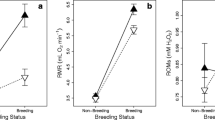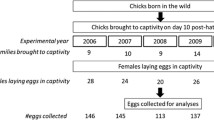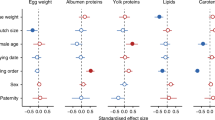Abstract
Maternal effects influence the phenotype of offspring through non-genetic mechanisms, and thus are important components of individual life-histories and act as drivers of and/or constraints on phenotypic evolution. A maternal effect common in egg-laying vertebrates is provisioning of the yolk with carotenoids, organic pigments that often color sexual ornaments and are hypothesized to play positive and substantial physiological roles. In a recent study, yolks of great tit (Parus major) eggs were directly supplemented with carotenoids, and the effects on offspring fitness proxies measured (Marri and Richner in Oecologia 176:371–377, 2014a). Nestlings from supplemented broods were heavier early in development and more likely to fledge, but otherwise equivalent to control nestlings. The authors consider in detail the potential physiological mechanisms that might underlie this result, and here I expand on their Discussion by considering a non-exclusive explanation: that parents provided higher quality care to broods that received supplemental carotenoids. I discuss the general non-independence of pre- and post-hatching/parturition maternal effects when parents care for offspring, and then briefly review evidence that carotenoids specifically are tied to the intensity of avian begging displays. Finally, I detail how inclusive fitness opportunities and constraints shape the adaptive landscape in which maternal effects operate, highlighting both theoretical and applied concerns surrounding questions about the adaptiveness of maternal effects.
Similar content being viewed by others
References
Berthouly A, Helfenstein F, Richner H (2007) Cellular immune response, stress resistance and competitiveness in nestling great tits in relation to maternally transmitted carotenoids. Funct Ecol 21:335–343
Blount JD, Houston DC, Møller AP (2000) Why egg yolk is yellow. Trends Ecol Evol 15:47–49
Dugas MB (2009) House sparrow (Passer domesticus) parents preferentially feed nestlings with mouth colours that appear carotenoid-rich. Anim Behav 78:767–772
Dugas MB (2012) Cross-fostering reveals that among-brood differences in ornamental mouth coloration mostly reflect rearing conditions in nestling house sparrows. Biol J Linn Soc 106:169–179
Dugas MB, McGraw KJ (2011) Proximate correlates of carotenoid-based mouth coloration in nestling house sparrows. Condor 111:691–700
Dugas MB, Yeager J, Richards-Zawacki CL (2013) Carotenoid supplementation enhances reproductive success in captive strawberry poison frogs (Oophaga pumilio). Zoo Biol 32:655–658
Ewen JG, Thorogood R, Karadas F, Cassey P (2008) Condition dependence of nestling mouth colour and the effect of supplementing carotenoids on parental behaviour in the hihi (Notiomystis cincta). Oecologia 157:361–368
Fitze PS, Tschirren B (2006) No evidence for survival selection on carotenoid-based nestling coloration in great tits (Parus major). J Evol Biol 19:618–624
Galvan I, Amo L, Sanz JJ (2008) Ultraviolet–blue reflectance of some nestling patches mediates parental favouritism in great tits Parus major. J Avian Biol 39:277–282
Götmark F, Ahlström M (1997) Parental preference for red mouths of chicks in a songbird. Proc R Soc Lond B 264:959–962
Griggio M, Morosinotto C, Pilastro A (2009) Nestlings’ carotenoid feather ornament affects parental allocation strategy and reduces maternal survival. J Evol Biol 22:2077–2085
Groothuis TGG, Müller W, von Engelhardt N, Carere C, Eising C (2005) Maternal hormone as a tool to adjust offspring phenotype in avian species. Neurosci Biobehav Rev 29:329–352
Heeb P, Schwander T, Faoro S (2003) Nestling detectability affects parental feeding preferences in a cavity-nesting bird. Anim Behav 66:637–642
Helfenstein F, Berthouly A, Tanner M, Karadas F, Richner H (2008) Nestling begging intensity and parental effort in relation to prelaying carotenoid availability. Behav Ecol 19:108–115
Hinde CA, Buchanan KL, Kilner RM (2009) Prenatal environment effects match offspring begging to parental provisioning. Proc R Soc Lond B 276:2787–2794
Hunt S, Kilner RM, Langmore NE, Bennett ATD (2003) Conspicuous, ultraviolet-rich mouth colours in begging chicks. Proc R Soc Lond B 270:S25–S28
Isaksson C (2009) The chemical pathway of carotenoids: from plants to birds. Ardea 97:125–128
Isaksson C, Uller T, Andersson S (2006) Parental effects on carotenoid-based plumage coloration in nestling great tits, Parus major. Behav Ecol Sociobiol 60:556–562
Marri V, Richner H (2014a) Yolk carotenoids increase fledging success in great tit nestlings. Oecologia 176:371–377
Marri V, Richner H (2014b) Differential effects of vitamins E and C and carotenoids on growth, resistance to oxidative stress, fledging success and plumage coloration in wild great tits. J Exp Biol 217:1476–1484
Marshall DJ, Uller T (2007) When is a maternal effect adaptive? Oikos 116:1957–1963
Mock DW, Parker GA (1997) The evolution of sibling rivalry. Oxford University Press, Oxford
Mock DW, Schwagmeyer PL, Parker GA (2005) Male house sparrows deliver more food to experimentally subsidized offspring. Anim Behav 70:225–236
Mock DW, Dugas MB, Strickler SA (2011) Honest begging: expanding from signal of need. Behav Ecol 22:909–917
Moore AJ, Brodie ED III, Wolf JB (1997) Integrating phenotypes and the evolutionary process: I. Direct and indirect genetic effects of social interactions. Evolution 51:1352–1362
Müller W, Lessels CM, Korsten P, von Engelhardt N (2007) Manipulative signals in family conflict? On the function of maternal yolk hormones in birds. Am Nat 169:E84–E96
Nur N (1984) The consequences of brood size for breeding blue tits I. Adult survival, weight change and the cost of reproduction. J Anim Ecol 53:479–496
Remeš V, Krist M, Bertacche V, Stradi R (2007) Maternal carotenoid supplementation does not affect breeding performance in the great tit (Parus major). Funct Ecol 21:776–783
Saino N, Ninni P, Calza S, Martinelli R, de Bernardi F, Møller AP (2000) Better red than dead: carotenoid-based mouth colouration reveals infection in barn swallow nestlings. Proc R Soc Lond B 267:57–61
Saino N, Bertacche V, Ferrari RP, Martinelli R, Møller AP, Stradi R (2002) Carotenoid concentration in barn swallow eggs is influenced by laying order, maternal infection and paternal ornamentation. Proc R Soc Lond B 269:1729–1733
Saino N, Ferrari R, Romano M, Martinelli R, Møller AP (2003) Experimental manipulation of egg carotenoids affects immunity of barn swallow nestlings. Proc R Soc Lond B 270:2485–2489
Schwabl H, Lipar J (2002) Hormonal regulation of begging behaviour. In: Wright J, Leonard M (eds) The evolution of begging: competition, cooperation and communication. Kluwer, Dordrecht, pp 221–244
Svensson PA, Wong BBM (2011) Carotenoid-based signals in behavioural ecology: a review. Behaviour 148:131–189
Tanner M, Richner H (2008) Ultraviolet reflectance of plumage for parent-offspring communication in the great tit (Parus major). Behav Ecol 19:369–373
Thorogood R, Kilner RM, Karadas F, Ewen JG (2008) Spectral mouth colour of nestlings changes with carotenoid availability. Funct Ecol 22:1044–1051
Thorogood R, Ewen JG, Kilner RM (2011) Sense and sensitivity: responsiveness to offspring signals varies with the parents’ potential to breed again. Proc R Soc Lond B 278:2638–2645
Tschirren B, Fitze PS, Richner H (2003) Proximate mechanisms of variation in the carotenoid-based plumage coloration of nestling great tits (Parus major L.). J Evol Biol 16:91–100
Tschirren B, Fitze PS, Richner H (2005) Carotenoid-based nestling colouration and parental favoritism in the great tit. Oecologia 243:477–482
Uller T (2008) Developmental plasticity and the evolution of parental effects. Trends Ecol Evol 23:432–438
Walker LK, Armstrong DP, Brekke P, Chauvenet ALM, Kilner RM, Ewen JG (2013) Giving hihi a helping hand: assessment of alternative rearing diets in food supplemented populations of an endangered bird. Anim Conserv 16:538–545
Wolf JB, Wade MJ (2009) What are maternal effects (and what are they not)? Philos Trans R Soc Lond B 364:1107–1115
Acknowledgments
Ryan A. Martin, Michael P. Moore, Douglas W. Mock and an anonymous reviewer provided helpful comments that improved this commentary.
Author information
Authors and Affiliations
Corresponding author
Additional information
Communicated by Markku Orell.
Rights and permissions
About this article
Cite this article
Dugas, M.B. Commentary: Parental care and the proximate links between maternal effects and offspring fitness. Oecologia 177, 1089–1092 (2015). https://doi.org/10.1007/s00442-015-3266-x
Received:
Accepted:
Published:
Issue Date:
DOI: https://doi.org/10.1007/s00442-015-3266-x




